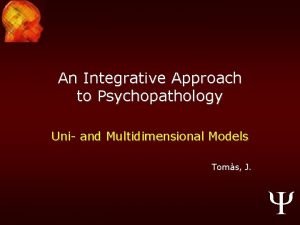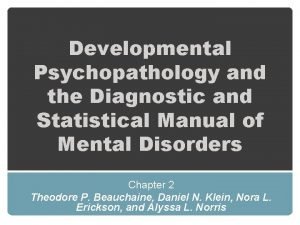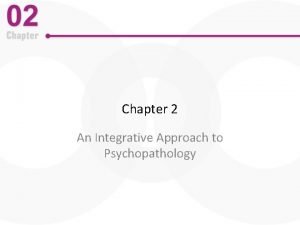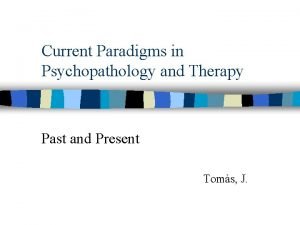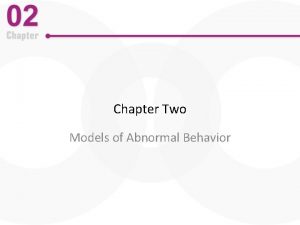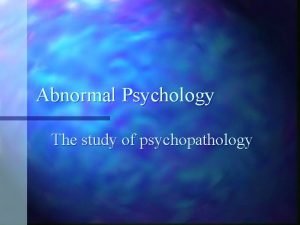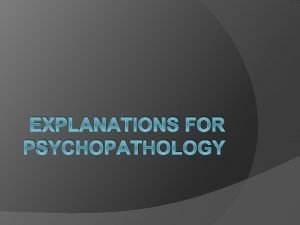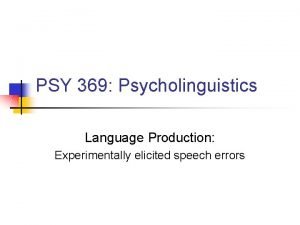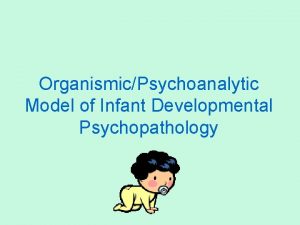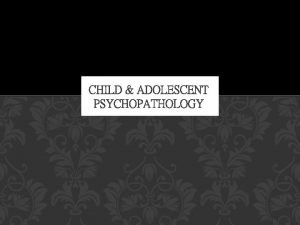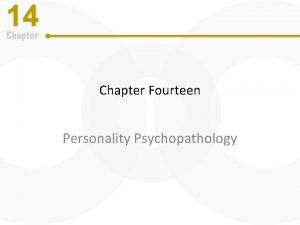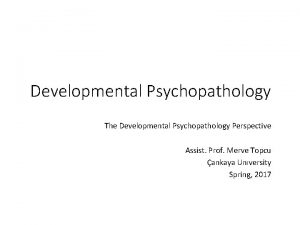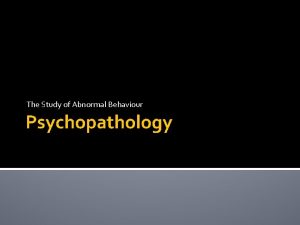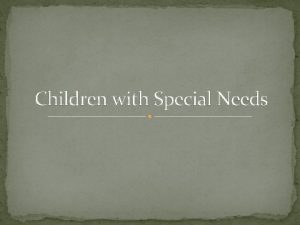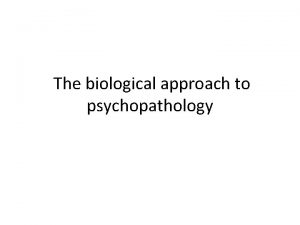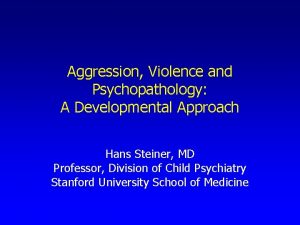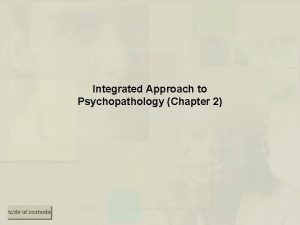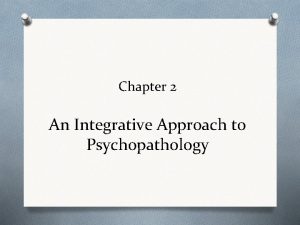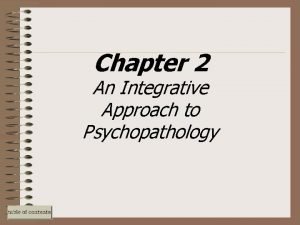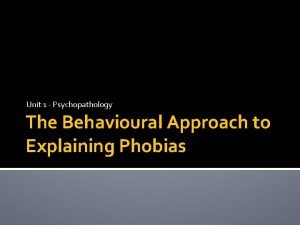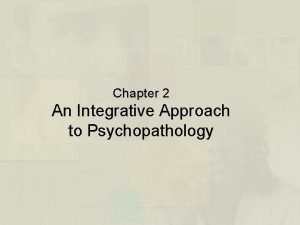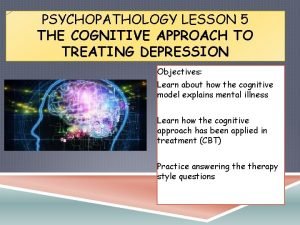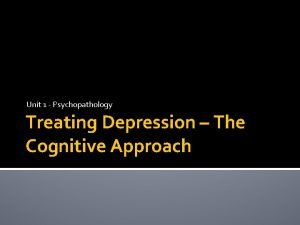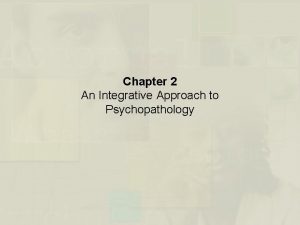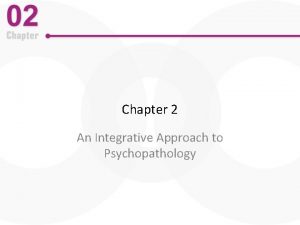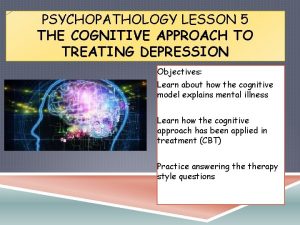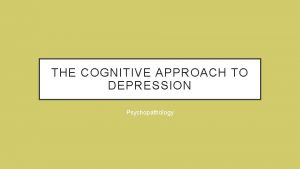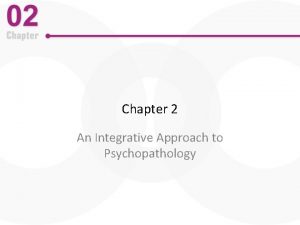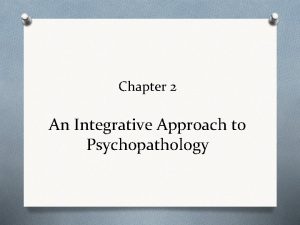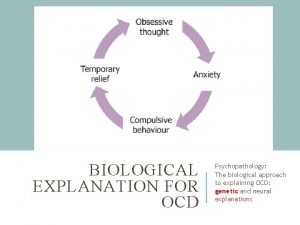The network approach to psychopathology opportunities for an






























- Slides: 30

The network approach to psychopathology: opportunities for an empirically based revision of contemporary classification systems Eiko Fried Psychological Methods University of Amsterdam www. eiko-fried. com Twitter @Eiko. Fried Slides available at www. eiko-fried. com/ABCT 2016 ABCT New York City, October 29 2016

Psychiatric nosology Diagnostic categories do often not meet orthodox criteria for validity • Precise diagnostic boundaries / comorbidity (10. 3389/fpsyg. 2015. 00309) • Lack of biomarkers specificity (10. 3389/fpsyg. 2015. 00309) • Clear clinical presentation (10. 1016/j. jad. 2014. 10. 010; 10. 1007/s 12207 -014 -9186 -y) 2

10. 1016/j. jad. 2016. 10. 019 3

Summary 4

Research Domain Criteria • Solution: RDo. C that cuts across current diagnostic criteria D s 1 s 2 s 3 A s 4 s 5 s 1 s 2 s 3 s 4 s 5 5

Research Domain Criteria • Solution: RDo. C that cuts across current diagnostic criteria • However, similar to the DSM (and other dimensional approaches), RDo. C based on assumption that specific symptoms co-occur in syndromes because they share a common cause ? s 1 s 2 s 3 s 4 s 5 6

Research Domain Criteria “First, the RDo. C framework conceptualizes mental illnesses as brain disorders. ” ? s 1 s 2 s 3 s 4 s 5 7

NETWORKS ! 8

Network perspective • Symptoms causally influence each other in complex systems • Not new idea, but we can now estimate networks in models 9

PTSD https: //osf. io/p 69 m 7/ 10

Substance abuse 10. 1016/j. drugalcdep. 2016. 02. 005; D 2—withdrawal, D 5—monopolizes time 11

Bereavement 10. 1037/abn 0000028 12

Psychosis 10. 1093/schbul/sbw 055 13

Comorbidity ? D s 1 s 2 s 3 A s 4 s 5 s 1 s 2 s 3 s 4 s 5 14

Comorbidity https: //osf. io/6 n 8 cg/ 15

Comorbidity 10. 1017/S 0033291716002300 10. 1037/abn 0000002 16

Centrality • A central symptom is one that exhibits a large number of connections in a network https: //osf. io/6 n 8 cg/ 17

Centrality 10. 1016/j. jad. 2015. 09. 005 18

Centrality 19

Nosology: bottom-up http: //wp. me/p 801 LW-4 c 20

Nosology: bottom-up http: //wp. me/p 801 LW-4 c 21

Nosology: bottom-up http: //wp. me/p 801 LW-4 c 22

Hybrid models • Common causes for some sets of symptoms? (https: //osf. io/mh 3 cf/) – Trauma → PTSD symptoms – Particular life events → particular depression symptoms 23

Hybrid models • Common causes for some sets of symptoms? (https: //osf. io/mh 3 cf/) – Trauma → PTSD symptoms – Particular life events → particular depression symptoms 24

But what about temporal networks Eiko? Cross-sectional Time-series 25

Temporal networks http: //psych-networks. com/wp-content/uploads/2016/10/Thesis_LFBringmann-w-voorkant. pdf 26

Resources • “Mental disorders as networks of problems: a review of recent insights” (https: //osf. io/6 n 8 cg) • “Moving forward: challenges and directions for psychopathological network theory and methodology” (https: //osf. io/mh 3 cf) – – Causality Validity of network models Statistical robustness of network models Heterogeneity 27

www. psych-networks. com 28

Fantastic network colleagues & collaborators Denny Borsboom, Angelique Cramer, Sacha Epskamp, Marie Deserno, Claudia van Borkulo, Lynn Boschloo, Laura Bringmann, Francis Tuerlinckx, Don Robinaugh, Courtney Beard, Jason Elias, Alex Millner, Richard Mc. Nally, Kendler, Steven Aggen, Hudson Santos, Cherie Armour, Marieke Wichers, Fionneke Bos. 29

Eiko Fried www. eiko-fried. com Twitter @Eiko. Fried Slides are available at www. eiko-fried. com/ABCT 2016 ABCT New York City, October 29 2016
 Multidimensional integrative approach
Multidimensional integrative approach Developmental psychopathology approach
Developmental psychopathology approach Integrative approach to psychopathology
Integrative approach to psychopathology Biological paradigm of psychopathology
Biological paradigm of psychopathology Multipath model of psychopathology
Multipath model of psychopathology What is psychopathology
What is psychopathology Bacteria causing syphilis
Bacteria causing syphilis Speech errors examples
Speech errors examples Psychopathology
Psychopathology Kontinuitetshantering i praktiken
Kontinuitetshantering i praktiken Typiska drag för en novell
Typiska drag för en novell Tack för att ni lyssnade bild
Tack för att ni lyssnade bild Ekologiskt fotavtryck
Ekologiskt fotavtryck Varför kallas perioden 1918-1939 för mellankrigstiden
Varför kallas perioden 1918-1939 för mellankrigstiden En lathund för arbete med kontinuitetshantering
En lathund för arbete med kontinuitetshantering Särskild löneskatt för pensionskostnader
Särskild löneskatt för pensionskostnader Vilotidsbok
Vilotidsbok Sura för anatom
Sura för anatom Vad är densitet
Vad är densitet Datorkunskap för nybörjare
Datorkunskap för nybörjare Tack för att ni lyssnade bild
Tack för att ni lyssnade bild Mall för debattartikel
Mall för debattartikel Magnetsjukhus
Magnetsjukhus Nyckelkompetenser för livslångt lärande
Nyckelkompetenser för livslångt lärande Påbyggnader för flakfordon
Påbyggnader för flakfordon Arkimedes princip formel
Arkimedes princip formel Svenskt ramverk för digital samverkan
Svenskt ramverk för digital samverkan Lyckans minut erik lindorm analys
Lyckans minut erik lindorm analys Presentera för publik crossboss
Presentera för publik crossboss Argument för teckenspråk som minoritetsspråk
Argument för teckenspråk som minoritetsspråk Kanaans land
Kanaans land
